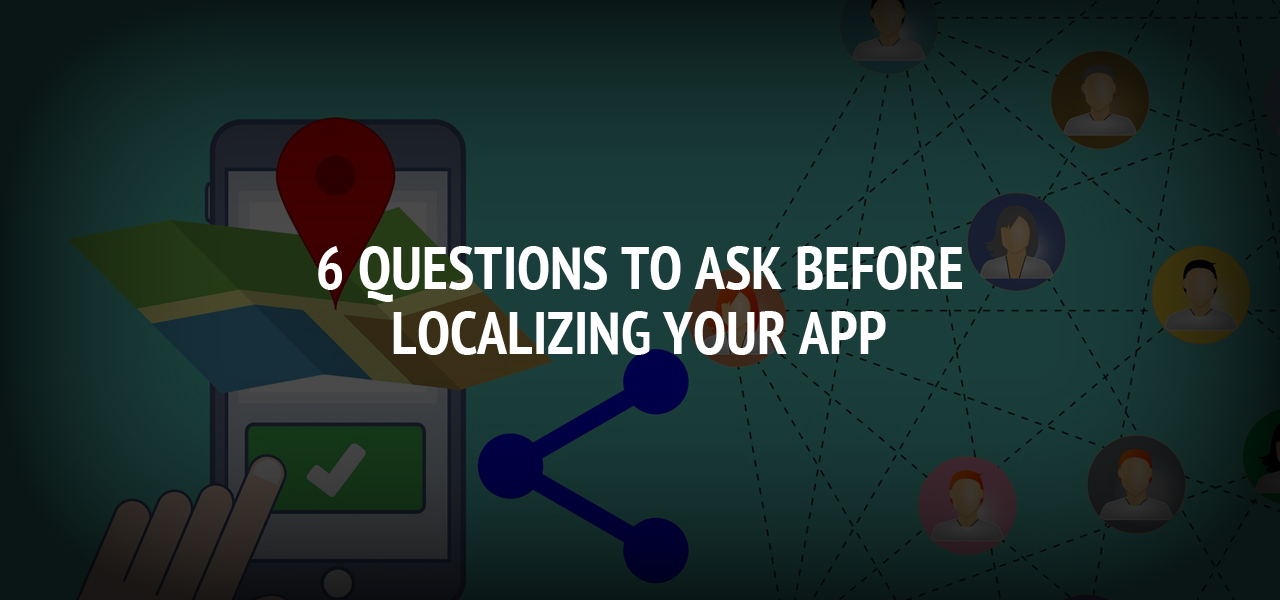6 Questions To Ask Before Localizing Your App

We live in an ever-more connected world, and for new tech products, there is now the real prospect of targeting a global customer base. Localization is the process of adapting your app for different regions, languages and cultures. It's one of the most important aspects of creating an app if you want it to succeed in countries outside your own. Localization will ensure that every user has the same positive experience with your app no matter where they live or what language they speak.
In this article, we will explain what app localization entails, why it is so important, and highlight six key questions you need to ask yourself when you get started with the localization process.
What is App Localization?
At its simplest, app localization means that your app's text is translated from the original language into a new language. This should include everything from menus to product descriptions to error messages.
However, the most effective localization does not just change the language, it also considers other important aspects such as culture, idioms and slang as well as practical changes like international payment systems.
Why Use Localization?
There are several key reasons why mobile apps should be localized:
- You can reach new users in areas where your app is not yet available.
- You can target overseas markets where there is less competition or a clear gap in the market
- You can build your brand in new markets in anticipation of future products
- You can bring in new revenue streams, either through sales or app store subscriptions
- You can make your app more user-friendly
With so many potential benefits of localization, it is crucial that you get the process right. To help put you on the right path, here are six key questions to ask yourself:
1. When Should I Start Planning for Localization?
It is very important that you start planning your app localization at the earliest possible stage, preferably during the early app or product design stages. This is because the earlier you start, the easier it will be to design your app with localization in mind. For example, if you are building a chat-based app that relies on text input then being able to do this in multiple languages should be part of your app function and screen layout plans from day one.
2. Which Regions Should I Focus On?
Generally speaking, the best regions to focus your localization efforts on are those with the most commonly spoken languages and the most potentially profitable markets. If your app's original language is in English, the best regions to localize for are likely to include China, India, Brazil and Spanish-speaking countries across Latin America because these are enormous emerging markets.
However, there are certain apps that are designed for a specific purpose and region where language and profitability are not the priority. For example, there is a range of apps designed to help people in the Third World with everything from healthcare to deliveries in hard-to-reach places.
3. Can I Use the Same Version of the App in Different Regions?
Absolutely not. It is crucial that you develop unique versions of your app for each specific region that the app will be available. Your intention should be to give every user the same positive experience regardless of geography or language and that means more than a simple translation.
You should always have someone on your localization team who understands the culture, history and heritage of each region so that they can best adapt your app for that specific population.
In order to create a unique version of your app for each region you will need to consider:
- The most commonly spoken native languages in each region.
- Key cultural factors that shape the values, priorities and behaviours of people in the region.
- How you can adapt your app so as to best fit with the local language, culture and norms.
- Any significant/taboo/lucky/unlucky colours, numbers or symbols in the region.
- Content on your original app that could be potentially offensive in other cultures.
- Differences in marketing approaches between different regions
- Compatibility with secure international technology and software such as integrated online payment solutions specific to each region.
4. Do I Need to Find a Localization Service Provider?
100% yes! A localization service provider (LSP) is very important to ensure that every aspect of your app localization is up to scratch. Even major companies with their own teams of translators and international developers employ a mixture of in-house and outsourced localization to make sure their app is up to scratch and that they haven't overlooked something important.
An experienced LSP can:
- Recommend which languages and geographical regions to prioritize for localization.
- Be responsible for translating your app into all the different native languages (including any local dialects) that are spoken in those target regions.
- Help you create a unique version of each language where necessary, such as including slang or other local linguistic conventions specific to different areas.
- Check all translations against cultural sensitivities so there aren't any issues with words/phrases having two meanings, negative connotations or potentially offensive translations.
- Provide detailed reports during the localization process to help make the process run smoothly.
5. After Localization has been Completed, Is That It?
Not if you want your app to succeed. Successful localization is all about the details, so once you've translated and localized your app for each region, you will need to check the new versions for potential issues. The main areas to look at include:
- User Interface Issues - This includes everything from the app's usability, its general layout, navigation and structure, to the messages or prompts displayed on the screen.
- Language Issues - It is important that you check the translations carefully for any incorrect grammar/syntax as well as idioms or phrases with different meanings when translated from one language to another. You will also need to check for any spelling errors or inconsistencies in the text.
- Common Errors - You will need to check general functionality, compatibility and performance issues as well as bugs that may have been introduced during localization. This is especially important if your app uses integrated online payment solutions or other secure systems that are specific to certain regions. You will also need to check incorrect formatting of dates and other numbers as these can vary by region.
6. Can App Localization Wait?
With the app market and smartphone market in general growing exponentially year on year, there has never been a better time to make your app available to international customers. Worldwide there are currently around 6.4 billion smartphone users but this number is forecast to rise to 7.5 billion in 2026. China and India, the two biggest markets that all app developers should be looking to target, currently have 918 million and 440 million users respectively. When you consider that the US and the UK (the two countries with the most English-speaking smartphone users) only have 270 million and 53 million users respectively, you can see why localizing your app for these regions as soon as possible is so important.
About The Author
Related Blog
View All-
Discussion about the Objectives, Benefits of the Affiliate Tracking app
What is affiliate tracking? It is a technology to manage or track the marketing activities of the affiliates. The app tracks the performance of clicks, the impressions, the views of advertising materials. The ads like links, banners when used with affiliate tracking ...
-
7 Useful Budget Apps Ruling Personal Finance Management
Every breadwinner realizes the weight of responsibility that befalls their shoulders. From creating a budget to tweak some savings by the end of the month, one has to balance their earnings on the tightrope of strict finances. Budgets always aren’t convenient ...






